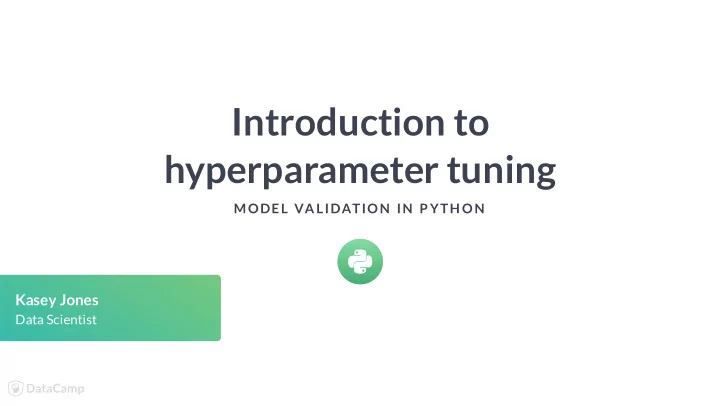

Introduction to hyperparameter tuning MODEL VALIDATION IN P YTH ON Kasey Jones Data Scientist
Model parameters Parameters are: Learned or estimated from the data The result of �tting a model Used when making future predictions Not manually set MODEL VALIDATION IN PYTHON
Linear regression parameters Parameters are created by �tting a model: from sklearn.linear_model import LinearRegression lr = LinearRegression() lr.fit(X, y) print(lr.coef_, lr.intercept_) [[0.798, 0.452]] [1.786] MODEL VALIDATION IN PYTHON
Linear regression parameters Parameters do not exist before the model is �t: lr = LinearRegression() print(lr.coef_, lr.intercept_) AttributeError: 'LinearRegression' object has no attribute 'coef_' MODEL VALIDATION IN PYTHON
Model hyperparameters Hyperparameters: Manually set before the training occurs Specify how the training is supposed to happen MODEL VALIDATION IN PYTHON
Random forest hyperparameters Possible Values Hyperparameter Description (default) n_estimators Number of decision trees in the forest 2+ (10) max_depth Maximum depth of the decision trees 2+ (None) max_features Number of features to consider when making a split See documentation The minimum number of samples required to make a min_samples_split 2+ (2) split MODEL VALIDATION IN PYTHON
What is hyperparameter tuning? Hyperparameter tuning: Select hyperparameters Run a single model type at different value sets Create ranges of possible values to select from Specify a single accuracy metric MODEL VALIDATION IN PYTHON
Specifying ranges depth = [4, 6, 8, 10, 12] samples = [2, 4, 6, 8] features = [2, 4, 6, 8, 10] # Specify hyperparameters rfc = RandomForestRegressor( n_estimators=100, max_depth=depth[0], min_samples_split=samples[3], max_features=features[1]) rfr.get_params() {'bootstrap': True, 'criterion': 'mse' ... } MODEL VALIDATION IN PYTHON
Too many hyperparameters! rfr.get_params() {'bootstrap': True, 'criterion': 'mse', 'max_depth': 4, 'max_features': 4, 'max_leaf_nodes': None, 'min_impurity_decrease': 0.0, 'min_impurity_split': None, 'min_samples_leaf': 1, 'min_samples_split': 8, ... } MODEL VALIDATION IN PYTHON
General guidelines Start with the basics Read through the documentation T est practical ranges MODEL VALIDATION IN PYTHON
Let's practice! MODEL VALIDATION IN P YTH ON
RandomizedSearchCV MODEL VALIDATION IN P YTH ON Kasey Jones Data Scientist
Grid searching hyperparameters MODEL VALIDATION IN PYTHON
Grid searching continued Bene�ts: Drawbacks: T ests every possible combination Additional hyperparameters increase training time exponentially MODEL VALIDATION IN PYTHON
Better methods Random searching Bayesian optimization MODEL VALIDATION IN PYTHON
Random search from sklearn.model_selection import RandomizedSearchCV random_search = RandomizedSearchCV() Parameter Distribution: param_dist = {"max_depth": [4, 6, 8, None], "max_features": range(2, 11), "min_samples_split": range(2, 11)} MODEL VALIDATION IN PYTHON
Random search parameters Parameters: estimator : the model to use param_distributions : dictionary containing hyperparameters and possible values n_iter : number of iterations scoring : scoring method to use MODEL VALIDATION IN PYTHON
Setting RandomizedSearchCV parameters param_dist = {"max_depth": [4, 6, 8, None], "max_features": range(2, 11), "min_samples_split": range(2, 11)} from sklearn.ensemble import RandomForestRegressor from sklearn.metrics import make_scorer, mean_absolute_error rfr = RandomForestRegressor(n_estimators=20, random_state=1111) scorer = make_scorer(mean_absolute_error) MODEL VALIDATION IN PYTHON
RandomizedSearchCV implemented Setting up the random search: random_search =\ RandomizedSearchCV(estimator=rfr, param_distributions=param_dist, n_iter=40, cv=5) We cannot do hyperparameter tuning without understanding model validation Model validation allows us to compare multiple models and parameter sets MODEL VALIDATION IN PYTHON
RandomizedSearchCV implemented Setting up the random search: random_search =\ RandomizedSearchCV(estimator=rfr, param_distributions=param_dist, n_iter=40, cv=5) Complete the random search: random_search.fit(X, y) MODEL VALIDATION IN PYTHON
Let's explore some examples! MODEL VALIDATION IN P YTH ON
Selecting your �nal model MODEL VALIDATION IN P YTH ON Kasey Jones Data Scientist
# Best Score rs.best_score_ 5.45 # Best Parameters rs.best_params_ {'max_depth': 4, 'max_features': 8, 'min_samples_split': 4} # Best Estimator rs.best_estimator_ MODEL VALIDATION IN PYTHON
Other attributes rs.cv_results_ rs.cv_results_['mean_test_score'] array([5.45, 6.23, 5.87, 5,91, 5,67]) # Selected Parameters: rs.cv_results_['params'] [{'max_depth': 10, 'min_samples_split': 8, 'n_estimators': 25}, {'max_depth': 4, 'min_samples_split': 8, 'n_estimators': 50}, ...] MODEL VALIDATION IN PYTHON
Using .cv_results_ Group the max depths: max_depth = [item['max_depth'] for item in rs.cv_results_['params']] scores = list(rs.cv_results_['mean_test_score']) d = pd.DataFrame([max_depth, scores]).T d.columns = ['Max Depth', 'Score'] d.groupby(['Max Depth']).mean() Max Depth Score 2.0 0.677928 4.0 0.753021 6.0 0.817219 8.0 0.879136 MODEL VALIDATION IN PYTHON
Other attributes continued Uses of the output: Visualize the effect of each parameter Make inferences on which parameters have big impacts on the results Max Depth Score 2.0 0.677928 4.0 0.753021 6.0 0.817219 8.0 0.879136 10.0 0.896821 MODEL VALIDATION IN PYTHON
Selecting the best model rs.best_estimator_ contains the information of the best model rs.best_estimator_ RandomForestRegressor(bootstrap=True, criterion='mse', max_depth=8, max_features=8, max_leaf_nodes=None, min_impurity_decrease=0.0, min_impurity_split=None, min_samples_leaf=1, min_samples_split=12, min_weight_fraction_leaf=0.0, n_estimators=20, n_jobs=1, oob_score=False, random_state=1111, verbose=0, warm_start=False) MODEL VALIDATION IN PYTHON
Comparing types of models Random forest: rfr.score(X_test, y_test) 6.39 Gradient Boosting: gb.score(X_test, y_test) 6.23 MODEL VALIDATION IN PYTHON
Predict new data: rs.best_estimator_.predict(<new_data>) Check the parameters: random_search.best_estimator_.get_params() Save model for use later: from sklearn.externals import joblib joblib.dump(rfr, 'rfr_best_<date>.pkl') MODEL VALIDATION IN PYTHON
Let's practice! MODEL VALIDATION IN P YTH ON
Course completed! MODEL VALIDATION IN P YTH ON Kasey Jones Data Scientist
Course recap Some topics covered: Accuracy/evaluation metrics Splitting data into train, validation, and test sets Cross-validation and LOOCV Hyperparameter tuning MODEL VALIDATION IN PYTHON
Next steps Check out kaggle MODEL VALIDATION IN PYTHON
Next steps Coming soon! MODEL VALIDATION IN PYTHON
Thank you! MODEL VALIDATION IN P YTH ON
Recommend
More recommend